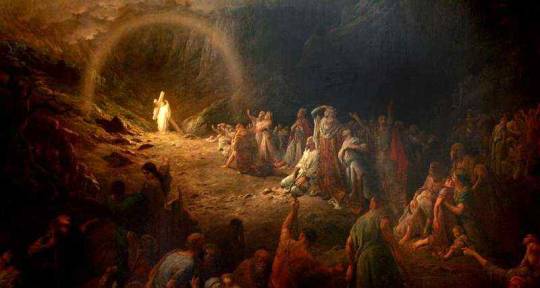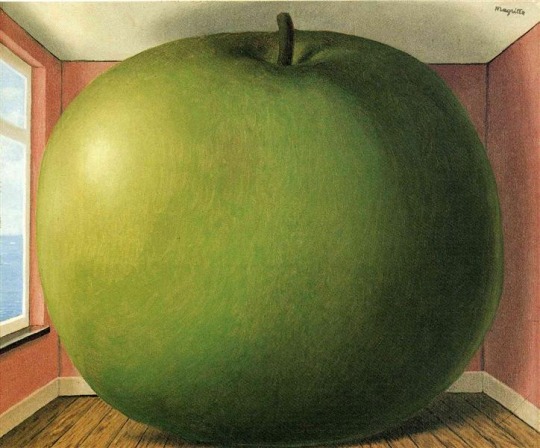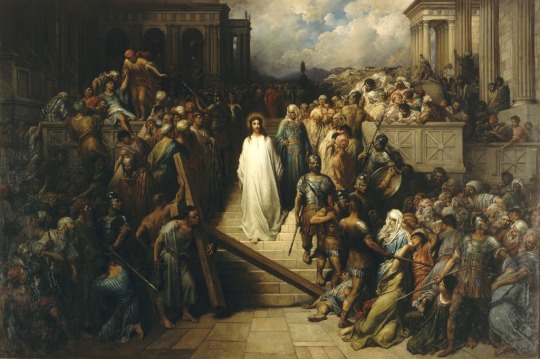#Son of man
Explore tagged Tumblr posts
Photo

Kings Worshipping the Beast (1497 / Woodcut) - Albrecht Dürer
#art#woodcut#German artist#book of revelation#the bible#son of man#worship the beast#monsters#albrecht dürer#woodcut 1497
384 notes
·
View notes
Text

11/15/2024
This guy needs a tree-chers' union.
JOKE-OGRAPHY: 1. In this Bible story, Jesus tells His disciples that there will be signs before the Son of Man (i.e. the Messiah, Jesus) returns at the end of days. The sun and moon will darken, and the stars will fall from the sky. He compares these signs to a tree sprouting leaves, pointing to a fig tree as an example. Just like the fig tree's new leaves are a sign that summer is on its way, these heavenly disasters will be a sign that the Son of Man is on His way. 2. In this cartoon, Jesus starts talking about the Son of Man like in the original Bible story. He gets to the part where he points out the fig tree and says, "Take a lesson from this fig tree." However, instead of the tree remaining respectfully silent like in the original story, the tree in this cartoon turns and interrupts him. It thinks that by "learn a lesson from this fig tree," Jesus meant for the tree to start teaching instead of Him. The tree is incorrect, as most trees are -- a flaw of their kind, and one of the many reasons God stripped them of their voices pre-Genesis (I assume).
#catholic#christian#jesus#comic#cartoon#catholic memes#christian memes#jesus memes#tomics#bible#tree#mark 13#son of man#fig tree#treecher#jack treecher for short
170 notes
·
View notes
Text

The Son of Man by René Magritte (1964)
The Psychology of Transgression and Guilt Magritte’s The Son of Man immediately captivates with its two central symbols: the apple and the figure’s formal attire. The apple, suspended in front of the man’s face, evokes not only the biblical narrative of Eden but also the Oedipal Complex, where transgression against the father’s law leads to guilt. In the biblical tale, Adam consumes the forbidden fruit offered by Eve, symbolizing the birth of self-awareness, shame, and the burden of guilt. In this painting, the man’s face is concealed behind the apple, echoing the unresolved guilt from that original transgression.
From a psychoanalytic perspective, the apple mirrors the child’s desire for the mother and the violation of paternal boundaries, evoking the tension between desire and punishment. Before consuming the apple, Adam was unaware of his nakedness, just as the child, before transgressing paternal laws, is innocent of their own desires. Magritte’s man, in contrast, is fully dressed—his body covered by a formal suit, suggesting an overcompensation for that earlier transgression. His attire, like the suit of a corporate leader, represents conformity to societal rules and the defensive structures built to contain one’s hidden impulses.
However, it’s the apple that holds the deepest psychological weight. By hiding the man’s face—his core of identity and expression—it creates a psychological tension between the desire to be seen and the fear of being exposed. For a leader or executive, this speaks to the unconscious burden carried beneath the polished exterior, where the drive for success is continually shaped by the fear of transgression and the guilt of overstepping social or professional boundaries.
The Suit as a Symbol of Conformity and Defense The man’s formal attire serves as more than just a uniform of professionalism—it becomes a psychological defense. The suit, much like the hat perched atop his head, symbolizes social status and conformity, a way to signal adherence to the expectations of society, much like corporate leaders navigate the demands of shareholders, regulatory bodies, and industry norms. Yet, behind this polished exterior, the apple remains—a reminder that no matter how much we align ourselves with social structures, the hidden burden of guilt and the desire to transgress still linger beneath the surface.
Leaders who resonate with this painting might feel an unconscious connection to this duality of identity. On one hand, they must project a facade of control, success, and conformity. On the other, they may grapple with the weight of unresolved guilt from past decisions or actions—choices that, like the apple, remain hidden from public view but deeply influence their sense of self.
Transgression, Authority, and the Pursuit of Power The Oedipal Complex present in this work also extends into the realms of power and authority. The apple, symbolizing forbidden desire, creates a tension with the suit, a marker of societal success and control. For those drawn to this painting, it may evoke a subconscious acknowledgment of the transgressive impulses that often drive ambition—the desire to challenge authority and push past boundaries, while simultaneously seeking approval from the very structures they seek to defy.
For executives or professionals who might display this work, The Son of Man serves as a psychological mirror, reflecting the internal struggles faced in their journey toward leadership. The fear of exposure, the guilt of transgression, and the need for external validation all intertwine within the image. It reminds us that no matter how elevated one becomes in status or authority, the unconscious drive to rebel and the weight of guilt are never fully erased.
The Apple as the Unconscious Burden of Guilt At its core, the apple not only hides the man’s face but represents the guilt of wanting more—more power, more success, more control. In leadership, this often translates into a continuous striving for achievement while carrying the fear of overstepping boundaries. The man’s face, hidden yet central, reminds us that in the pursuit of success, there is always a part of the self that remains concealed—driven by past transgressions and the desire to surpass societal limitations.
For those drawn to this painting, it could signal an unconscious recognition of the cost of ambition—that the pursuit of power, while necessary, also comes with a burden of guilt and the need to reconcile one’s hidden desires with public expectations.
#aesthetic#art history#psychoanalysis#artwork#contemporary art#modern art#art gallery#psychology#art collection#fine art#rene magritte#son of man#wealth#money#personal development#resilience#power#social status#introspection#artinspiration#art#art analysis
139 notes
·
View notes
Text
I "love" when nonchristians and exchristians try to use the title "Son of Man/Humanity" (because in hebrew it's "ben adam" and thus "son of humanity/a human") to try to be like "Seeeee!!1! Jesus was just a man! He said so himself!!!1" Because if you actually read the Bible you would know "Son of Man" is a more Divine title than "Son of God." And random Israelite is a Son of God, my friend, but only Jesus is Ben Adam, Son of Man. It is a claim to humanity AND divinity. Daniel 7.
#daniel 7#son of man#jesus christ#son of god#faith in jesus#god is good#jesus is king#faithinchrist#bible scripture#jesus#faith#keep the faith#christian#christianity#bible#read the bible
117 notes
·
View notes
Photo

~ Serve One Another ~
Via The Consecrated Woman | ENCOURAGING AND INSPIRING THE WORLD WITH DAILY BIBLE VERSES
41 notes
·
View notes
Text

Acts 7:56 (KJV) - And said, Behold, I see the heavens opened, and the Son of Man standing on the right hand of God.
29 notes
·
View notes
Text


Son of Man - "Letters to the Editor" shirt
not a band, but son of man is the clothing site/record label that josh newton and joe owned together, under which they released schadenfreude as with knives
listen to with knives on spotify, apple music, and support on bandcamp
photo source
23 notes
·
View notes
Text

#oefn#jesus christ#christ#christianity#christians#christ is king#christ is lord#jesus is coming#jesussaves#jesusislord#jesusisgod#follow jesus#seek god#christian faith#christian motivation#righteousness#lord jesus christ#son of god#son of man#god is good#god is love#god is real#god is kind#god is vengeance#god is wrath#faith in god#follow god#follow christ#repentance#we are sinners
18 notes
·
View notes
Text

The Outlander (for my old Friend @acommonloon ). "Don't mistake the American Dream for the Gospel of Jesus Christ." Alistair Begg.
#art#watercolor#americana#coming to america#jesus#lady liberty#liberty#liberty and justice#freedom#american jesus#advent#jesus christ#son of man#behold your king#ecce homo#behold the man#quote of the day#quote of today#alistair begg#mistake#american dream#good news#gospel#faith#religion#christ is lord
17 notes
·
View notes
Text

Carl Heinrich Bloch (Danish, 1834-1890) The Burial of Christ, ca.1873 ”For God so loved the world, that he gave his only begotten Son, that whosoever believeth in him should not perish, but have everlasting life.” - John 3:16, The Bible.
#carl heinrich bloch#karl heinrich bloch#danish art#danish#european art#christian art#catholic art#Jesus Christ#Son of God#Son of Man#the burial of Christ#art#oil painting#fine art#fine arts#traditional art#classical art#christian#christianity#christentum#catholic#catholicism#painting#denmark#burial of jesus
139 notes
·
View notes
Photo

“For as Jonah was three days and three nights in the belly of a huge fish, so the Son of Man will be three days and three nights in the heart of the earth.”
~Matthew 12:40
(Art by Gustave Dore)
#Scriptures#Bible#Lord Jesus Christ#Holy Saturday#Christian art#Gustave Dore#Harrowing of hell#descent into hell#savior#redeemer#God#Son of Man
351 notes
·
View notes
Photo

Verse of the Day - Luke 12:40
#second coming of Christ#Christ's return#end times#Bible verses#scripture#Luke#Son of Man#Jesus#Jesus is coming soon#Jesus is coming again
18 notes
·
View notes
Text


Above: René Magritte, Le Fils De L'Homme (The Son of Man), 1973 Lithograph
Below: Rene Magritte, The Listening Room, 1952
#rene magritte#surrealism#surrealist#surrealist art#surrealist painter#surrealist painting#belgian art#belgian artist#aesthetic#beauty#apple#son of man#modern art#art history#aesthetictumblr#tumblraesthetic#tumblrpic#tumblrpictures#tumblr art#tumblrstyle#artists on tumblr
69 notes
·
View notes
Text

🐾 “He will NEVER learn! You CAN’T learn to be one of us!!”~ Kerchak
#Kerchak#Young Tarzan#Tarzan#character study#Disney fanart#late night drawing#anger#rage#frustration#guilt#sadness#elephant stampede#jungle#Lance Henriksen#Alex D. Linz#Bruce W. Smith#John Ripa#Son of Man#Two Worlds One Family#disdain#disappointment#Kala#Terk#Tantor#tension and friction#Kerchak vs Tarzan#Tarzan II
5 notes
·
View notes
Text

gustave doré, “Christ leaving the praetorium”
#gustave doré#painting#christ leaving the praetorium#detail#credits#classical art#crucifixion#crown of thorns#jesus christ#son of god#son of man#the gospels#art#old art#traditional art#christianity
215 notes
·
View notes
Text

Matthew 12:31-32 (NLT) - “So I tell you, every sin and blasphemy can be forgiven—except blasphemy against the Holy Spirit, which will never be forgiven. Anyone who speaks against the Son of Man can be forgiven, but anyone who speaks against the Holy Spirit will never be forgiven, either in this world or in the world to come.
#Matthew 12:31-32#tell#every#sin#blasphemy#be forgiven#except#against#Holy Spirit#never#speak#Son of Man#come
44 notes
·
View notes